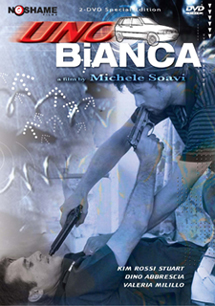|
Reviews of Recent Independent, Foreign, & Documentary Films in Theaters and DVD/Home Video
Directed by: Michele Soavi. Produced by: Pietro Valsecchi. Written by: Luigi Montefiori & Gabriele Romagnoli, with Marco Melega & Michele Soavi, based on the books Il caso della Uno Bianca & Baglioni e Costanza by Melega. Director of Photography: Gianni Mammolotti. Edited by: Anna Napoli. Music by: Gianni Bella. Released by: NoShame. Language: Italian with English subtitles. Country of Origin: Italy. 200 min. Not Rated. With: Kim Rossi Stuart, Dino Abbrescia, Valerio Milillo, Pietro Bontempo, Luciano Curreli, Massimo de Rossi, Bruno Armando, Claudio Botosso & Silvia de Santis. DVD Features: Disc 1: Part 1 of the movie. Introduction by producer Pietro Valsecchi. “How to Get Action into Truth” – Interview with writer Luigi Montefiori (aka George Eastman). “We Did It Like Cinema” – Interview with producer Pietro Valsecchi. “It Was NOT Business As Usual” – Interview with cinematographer Gianni Mammolotti. Disc 2: Part 2 of the movie. Two behind-the-scenes featurettes. Still gallery. Booklet – including liner notes & talent bios.
The DVD back cover for Uno Bianca proclaims it unlike anything seen in prime time. This should be revised to declare the 2001 Italian TV police drama as unlike just one thing seen on episodic TV – procedural crime shows. While the material is familiar, the film, as directed by Italian cinema veteran Michele Soavi, provides an entertaining contribution to the genre. Based on the real-life investigation into a 1980s wave of crime and violence by a white Fiat Uno-riding gang that robbed banks, grocery stores, and gas stations, it focuses on two fictionalized police detectives – pretty boy Valerio (Kim Rossi Stuart) and comic sidekick Rocco (Dino Abbrescia) – seeking the killers of their superior officer. In the process, they discover the perps are their colleagues.
Uno Bianca forges a striking style all its own through its eclectically energetic craftsmanship. From opening close-ups on the arming of an assault rifle, characteristic of the frenetic feel of CSI’s flashback sequences, to the emphatic booms on the soundtrack (à la the punctuating gavel sounds of Law & Order), the miniseries deftly juggles other visual strokes: circular panning shots and exquisitely suspenseful slow-mo moments.
While Stuart and Abbrescia compellingly play cops married to their job, there is not much else for them to work with. A lot of their dialogue sounds expository (or maybe something gets lost in translation). Much of their predicament, such as getting in too deep while infiltrating the gang, is old hat. While there is conflict, including a scene in which Valerio must decide if he should kill innocent people, this feels underdeveloped. More moral complexity exists on The Shield. Indeed, considering the filmmakers’ knowledge of genre, the cops’ one-dimensional naiveté about corruption and ensuing ignorance of the obvious begs the question, “Haven’t these guys seen Serpico?”
DVD Extras: Most entertaining is the interview with screenwriter Luigi Montefiori, who unabashedly states that Soavi’s “ability to scratch the surface and look deeply into a character is inversely proportional to his ability to use the camera.” Similarly seemingly oblivious to giving offense, Montefiori later discusses another director he worked with, Ari Massaccesi (AKA Joe D’Amato), saying that Massaccesi’s congeniality was stronger than his directorial skill. Both instances might be explained by jealousy. Montefiori readily admits his own directing efforts were disastrous. Nevertheless, Montefiori glosses over the considerable problems in his script for Uno Bianca. He merely acknowledges an awareness that the difficulty for him in writing it was that nothing much happened to the real-life investigators over the course of their long stakeout. This could as well explain why the film, though gesturing toward moral conflict, does not grapple with it (did Montefiori feel a need to keep Valerio's hands unsullied with blood?), and why not much actually changes for any of the characters, besides the killers. The screenwriter’s claim of making his characters morally ambiguous also rings hollow, considering the clear good-versus-bad delineations in the film. Other than that, cinematographer Gianni Mammolotti’s comment during his interview on the realistic nature of what is – despite his protestations otherwise – such a heavily stylized film is worth pondering, if only to speculate on how he could conceivably make that remark. Reymond Levy
|

